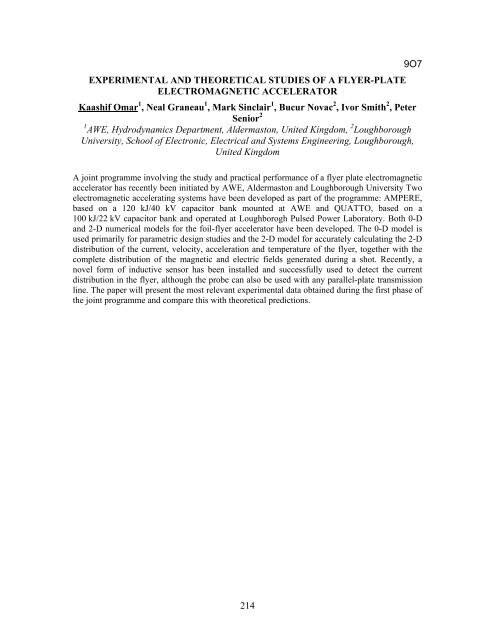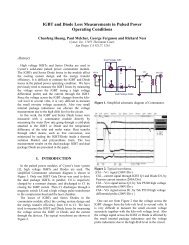- Page 1:
BOOK OF ABSTRACTS 2012 Internationa
- Page 4 and 5:
Stangenes Industries, Inc. 1052 Eas
- Page 6 and 7:
2012 IPMHVC COMMITTEE CHAIRS AND ST
- Page 8 and 9:
Chunqi Jiang University of Southern
- Page 10 and 11:
CONFERENCE SPONSORS AND SUPPORTERS
- Page 12 and 13:
Sunday, June 3, 2012 2012 IEEE IPMH
- Page 14 and 15:
Wednesday, June 6, 2012 7:15 - 8:15
- Page 16 and 17:
Plenary 1 Session Chair: Hulya Kirk
- Page 18 and 19:
Poster Session 1: Solid State Modul
- Page 20 and 21:
1P21 1P22 1P23 1P24 1P25 1P26 1P27
- Page 22 and 23:
1P43 1P44 1P45 1P46 1P47 1P48 1P49
- Page 24 and 25:
1P61 1P62 1P63 1P64 1P65 1P66 1P67
- Page 26 and 27:
3O6 DESIGN OF AN 80KV, 40A RESONANT
- Page 28 and 29:
5O7 EFFECT OF CURRENT PULSE WIDTH O
- Page 30 and 31:
2P9 2P10 2P11 2P12 2P13 2P14 2P15 2
- Page 32 and 33:
2P27 2P28 2P29 2P30 2P31 2P32 2P33
- Page 34 and 35:
2P46 2P47 MEASUREMENT AND ANALYSIS
- Page 36 and 37:
2P65 2P66 2P67 2P68 2P69 2P70 2P71
- Page 38 and 39:
8O7 A NEW TRIGGERING TECHNOLOGY BAS
- Page 40 and 41:
10O7 THREE-DIMENSIONAL PARTICLE-IN-
- Page 42 and 43:
3P15 3P16 3P17 3P18 3P19 3P20 3P21
- Page 44 and 45:
3P38 3P39 3P40 3P41 3P42 3P43 3P44
- Page 46 and 47:
3P58 3P59 3P60 3P61 3P62 3P63 3P64
- Page 48 and 49:
11O8 A SIMULATION OF BREAKDOWN PARA
- Page 51 and 52:
HIGH VOLTAGE, BIOFUELS, AND CO-PROD
- Page 53 and 54:
SPICE ANALYSIS OF AN INNOVATIVE SOL
- Page 55 and 56:
5 1O5 NEW CONCEPTS FOR PULSED POWER
- Page 57 and 58:
THE SLAC P2 MARX Mark Kemp, Andrew
- Page 59 and 60:
SURFACE FLASHOVER MECHANISM ON THE
- Page 61 and 62:
INITIATION MECHANISM OF NEGATIVE PU
- Page 63 and 64:
INVESTIGATION OF VACUUM UV ABSORPTI
- Page 65 and 66:
REINFORCED INSULATION PROPERTIES OF
- Page 67 and 68:
FAST OPENING SWITCH APPROACH FOR HI
- Page 69 and 70:
SENSITIVITY ANALYSIS FOR THE CLIC D
- Page 71 and 72:
PARAMETRIC MEASUREMENTS OF SWITCHIN
- Page 73 and 74:
SOLID STATE FAST TRANSITION KICKER
- Page 75 and 76:
GROUND BASED RADAR MODULATOR SOLID-
- Page 77 and 78:
OPTIMUM TERA HERTZ PULSE AMPLITUDE
- Page 79 and 80:
DEVELOPMENT OF AN AUTOMATED TEST SE
- Page 81 and 82:
DV/DT IMMUNITY AND RECOVERY TIME CA
- Page 83 and 84:
HVCM TOPOLOGY ENHANCEMENTS TO SUPPO
- Page 85 and 86:
35 1P19 AN ULTRA FAST HYBRID TOTEM
- Page 87 and 88:
LONGEVITY OF HIGH POWER GAAS PCSS A
- Page 89 and 90:
ON-STATE RESISTANCE COMPARISON OF S
- Page 91 and 92:
41 1P25 INFLUENCE OF HYDROSTATIC PR
- Page 93 and 94:
43 1P27 INVESTIGATIONS ON THE DIELE
- Page 95 and 96:
INVESTIGATION OF AC DISCHARGES WITH
- Page 97 and 98:
47 1P31 CONDUCTION AND BREAKDOWN IN
- Page 99 and 100:
HIGH FIELD CONDUCTION IN HEAT RESIS
- Page 101 and 102:
SURFACE FLASHOVER OF NANODIELECTRIC
- Page 103 and 104:
53 1P37 MECHANISM FOR STIMULATED AC
- Page 105 and 106:
55 1P39 EXPERIMENTAL STUDY ON SURFA
- Page 107 and 108:
STUDY ON SURFACE FLASHOVER AND GAS
- Page 109 and 110:
59 1P43 STUDY ON THE DC SPACE CHARG
- Page 111 and 112:
FLASHOVER PERFORMANCE ALONE POLLUTE
- Page 113 and 114:
RESEARCH ON SURFACE FLASHOVER PROPE
- Page 115 and 116:
65 1P49 PERFORMANCE IMPROVEMENT OF
- Page 117 and 118:
ESTIMATION OF LIFT OFF FIELD OFF AN
- Page 119 and 120:
A CAPACITIVE LEVEL-SHIFTER FOR HIGH
- Page 121 and 122:
ANALYSIS OF DIELECTRIC ELECTRO ACTI
- Page 123 and 124:
73 1P57 DEVELOPMENT OF THE INVERTER
- Page 125 and 126:
75 1P59 AN ADJUSTABLE HVDC POWER SU
- Page 127 and 128:
77 1P61 HIGH-FREQUENCY HIGH-VOLTAGE
- Page 129 and 130:
79 1P63 RESEARCH ON THE RELIABLE TH
- Page 131 and 132:
R&D OF 14KV/25A DC HIGH VOLTAGE POW
- Page 133 and 134:
REDUCED COMMON MODE VOLTAGE IN DIRE
- Page 135 and 136:
IMPLEMENTATION OF DIRECT TORQUE CON
- Page 137 and 138:
PERFORMANCE EVALUATION OF CLASSICAL
- Page 139 and 140:
PERFORMANCE AND OPTIMIZATION OF A 3
- Page 141 and 142:
ENHANCED VOLTAGE RECOVERY OF HIGH V
- Page 143 and 144:
93 3O5 PULSE-TO-PULSE VOLTAGE REPRO
- Page 145 and 146:
DESIGN OF A COMPACT, BATTERY-POWERE
- Page 147 and 148:
97 4O1,2 (invited) COMPARISON BETWE
- Page 149 and 150:
CHARACTERISTICS OF CAVITATION BUBBL
- Page 151 and 152:
101 4O6 INVESTIGATING THE ROLE OF P
- Page 153 and 154:
ANALYSIS OF CORONA DISCHARGES IN CY
- Page 155:
TUESDAY
- Page 158 and 159:
106 5O1,2 (Invited) DESIGN AND PERF
- Page 160 and 161:
LOW JITTER, HIGH VOLTAGE, REPETITIV
- Page 162 and 163:
PERFORMANCE OF A CORONA-STABILISED
- Page 164 and 165:
X-RAY EMISSION FROM A TABLE-TOP X-P
- Page 166 and 167:
THE EFFECTS OF TEMPERATURE, MOISTUR
- Page 168 and 169:
THE EVOLUTION OF IEC 60034-18-41 FR
- Page 170 and 171:
118 6O6 A FILTER BANK APPROACH FOR
- Page 172 and 173:
APPLICATION HILBERT-HUANG TRANSFORM
- Page 174 and 175:
INVESTIGATION OF NON-HEATING STERIL
- Page 176 and 177:
SPECTROSCOPIC OBSERVATION OF MICRO
- Page 178 and 179:
INVESTIGATION OF OZONE PRODUCTION U
- Page 180 and 181:
DEVELOPMENT OF TECHNIQUES APPLYING
- Page 182 and 183:
PORE DYNAMICS INDUCED BY NSPEF: A C
- Page 184 and 185:
HIGH BLOOD SUGAR CONCENTRATION RESP
- Page 186 and 187:
MODELING OF DELIVERY OF SUBNANOSECO
- Page 188 and 189:
STUDY OF THE EFFICIENCY OF A PULSED
- Page 190 and 191:
HYDROPHOBIC IMPROVEMENT OF PMMA SUR
- Page 192 and 193:
140 2P20 A HIGH CURRENT LOW INDUCTA
- Page 194 and 195:
RESEARCH AND DEVELOPMENT OF DRIVERS
- Page 196 and 197:
PARALLEL OPERATION OF FOUR SPARK GA
- Page 198 and 199:
SELECTIVELY GROWN CARBON NANOTUBES
- Page 200 and 201:
AN ATMOSPHERIC PRESSURE GAS SWITCH
- Page 202 and 203:
EXPERIMENTAL RESEARCH OF ROD-SHAPED
- Page 204 and 205:
X-RAY BACKLIGHTING OF SINGLE-WIRE A
- Page 206 and 207:
EVALUATION OF TAPE-BASED STRESS GRA
- Page 208 and 209:
ASSESSMENT OF DIELECTRIC DEGRADATIO
- Page 210 and 211:
PERFORMANCE EVALUATION OF A NEW SYS
- Page 212 and 213:
DETERMINING ECONOMIC LIFE CYCLE FOR
- Page 214 and 215:
162 2P42 DETERIORATION TREND ON ELE
- Page 216 and 217:
RESEARCH ON ROGOWSKI COIL FOR MEASU
- Page 218 and 219: MEASUREMENT AND ANALYSIS OF INSULAT
- Page 220 and 221: THE LIGHTNING PROTECTION TESTS FOR
- Page 222 and 223: A COMPACT LOW INDUCTANCE PULSE ENER
- Page 224 and 225: SOLID-STATE PULSED POWER SYSTEM FOR
- Page 226 and 227: COMPACT 600 KV MULTI-PRIMARY WINDIN
- Page 228 and 229: DEVELOPMENT OF A RF BURST PULSE GEN
- Page 230 and 231: STATUS OF PROTOGEN THE FIRST INTEGR
- Page 232 and 233: LINEAR TRANSFORMER DRIVER (LTD) WIT
- Page 234 and 235: RAPID CAPACITOR CHARGING POWER SUPP
- Page 236 and 237: 184 2P64 DEVELOPMENT OF BRAUNBECK C
- Page 238 and 239: AN NS RISETIME GAS SWITCH WITH A MO
- Page 240 and 241: OPERATIONAL RESULTS OF PULSE SHAPIN
- Page 242 and 243: HIGH-VOLTAGE VACUUM ELECTRONIC SWIT
- Page 244 and 245: 192 7O1,2 (invited) COMMISSIONING A
- Page 246 and 247: DEVELOPMENT OF THE 1 MV/100 KA FAST
- Page 248 and 249: SOLID DIELECTRIC TRANSMISSION LINES
- Page 250 and 251: COMPACT PICOSECOND PULSE GENERATORS
- Page 252 and 253: EVOLUTION OF PLASMA DENSITY GENERAT
- Page 254 and 255: FLEXIBLE 50-OHM HIGH-VOLTAGE NANOSE
- Page 256 and 257: SOME CONSIDERATIONS TO THE ITER SNU
- Page 258 and 259: SUSCEPTIBILITY OF ELECTRO-EXPLOSIVE
- Page 261 and 262: 207 Plenary Session 3 PLS-II AS THE
- Page 263 and 264: ATMOSPHERIC ELECTROMAGNETIC PLASMAD
- Page 265 and 266: ANALYSIS AND SIMULATION OF ELECTROM
- Page 267: EXPERIMENTAL RESULTS FROM THE DESTR
- Page 271 and 272: RECIRCULATING PLANAR MAGNETRON EXPE
- Page 273 and 274: GENERATING OSCILLATING PULSES USING
- Page 275 and 276: GAS EVOLUTION OF NICKEL, STAINLESS
- Page 277 and 278: A DIELECTRIC RESONATOR ANTENNA BASE
- Page 279 and 280: OPTIMIZATION OF CORONA RING DESIGN
- Page 281 and 282: OPTIMIZATION OF A CATHODE CONFIGURA
- Page 283 and 284: EFFECTS OF CAPACITIVE VERSUS RESIST
- Page 285 and 286: DESIGN AND TEST OF 2250KV SEMI-FLEX
- Page 287 and 288: NUMERICAL MODELING OF UHV LABORATOR
- Page 289 and 290: 235 3P12 ELECTRIC FIELD STRESS ANAL
- Page 291 and 292: MHZ-LEVEL REPETITIVE MODULATORS FOR
- Page 293 and 294: A STABILITY OF LCLS LINAC MODULATOR
- Page 295 and 296: KLYSTRON MODULATOR DESIGN FOR THE L
- Page 297 and 298: A HIGH-REPETITION RATE PULSED ELECT
- Page 299 and 300: SNS LEBT CHOPPER FAILURE MODES AND
- Page 301 and 302: 247 3P24 METHOD OF CURRENT TRANSFOR
- Page 303 and 304: 249 3P26 AN EMPIRICAL STUDY ON EVAL
- Page 305 and 306: SHOCK COMPRESSION OF GAS-IMPREGNATE
- Page 307 and 308: ANALYSIS TO THE EAST NBI TRANSMISSI
- Page 309 and 310: COMPACT ELECTRIC POWER SYSTEM FOR T
- Page 311 and 312: 257 3P34 THE PRINCIPLE OF MAGNETIC
- Page 313 and 314: FREQUENCY AGILITY OF A FERRITE-LOAD
- Page 315 and 316: X-BAND RELATIVISTIC BACKWARD WAVE O
- Page 317 and 318: 263 3P40 OPEN TRANSVERSE ELECTROMAG
- Page 319 and 320:
CARRIER DYNAMICS AND ELECTRON ENERG
- Page 321 and 322:
INNOVATIVE SOLUTIONS TO HPM TESTING
- Page 323 and 324:
COMPARISON OF CSI COATED CARBON VEL
- Page 325 and 326:
271 3P48 STOCHASTIC MODEL OF METAL
- Page 327 and 328:
PULSED POWER SWITCH MODELING FOR BR
- Page 329 and 330:
ANALYSIS OF CURRENT-DIVIDING POST-H
- Page 331 and 332:
DYNAMIC BIFURCATION ANALYSIS OF ADV
- Page 333 and 334:
279 3P56 AN EMI MODEL OF HIGH FREQU
- Page 335 and 336:
281 3P58 SIMULATION OF PULSED ELECT
- Page 337 and 338:
283 3P60 HIGH VOLTAGE DIRECT CURREN
- Page 339 and 340:
285 3P62 OPTIMAL LOCATION AND PARAM
- Page 341 and 342:
ROLE OF FACTS DEVICES ON ZONAL CONG
- Page 343 and 344:
289 3P66 DEVELOPMENT AND PERFORMANC
- Page 345 and 346:
LIFETIME TESTING OF AIRIX ACCELERAT
- Page 347 and 348:
293 3P70 CAPACITOR DROOP COMPENSATI
- Page 349 and 350:
295 11O1,2 (Invited) LINEAR-INDUCTI
- Page 351 and 352:
FDTD MODELING OF FAST TRANSIENT CUR
- Page 353 and 354:
ESTIMATIONS OF THE ENERGY AVAILABLE
- Page 355 and 356:
A SIMULATION OF BREAKDOWN PARAMETER
- Page 357 and 358:
GLASS DIELECTRICS FOR POWER CAPACIT
- Page 359 and 360:
305 12O4 PULSED CURRENT LIMITATIONS
- Page 361 and 362:
DESIGN AND CONSTRUCTION OF A 250 KV
- Page 363 and 364:
ANALYSIS ON STRAY PARAMETERS IN A S
- Page 365 and 366:
Caron, Michel .....................
- Page 367 and 368:
Hu, Hepin..........................
- Page 369 and 370:
Luo, Haiyun .......................
- Page 371 and 372:
Reynaud, Denis.....................
- Page 373 and 374:
Wang, Baojie.......................
- Page 375 and 376:
321
- Page 377 and 378:
323
- Page 379 and 380:
325



